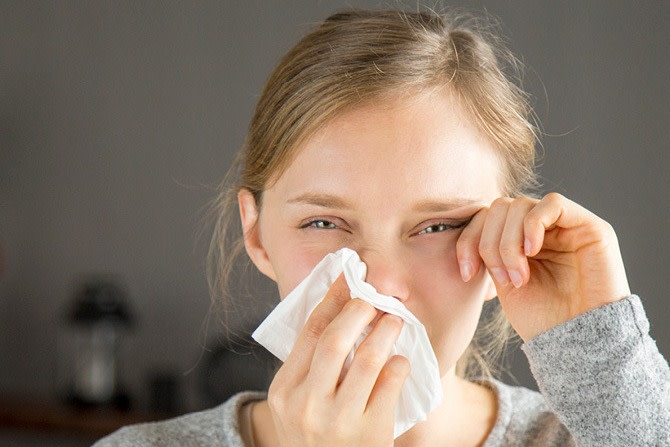Buy One, Get One 50% OFF Eyeglasses
* Restrictions apply. Ask a Team Member for details.
Understanding How to Treat Eye Allergies

Are allergies turning your eyes red and puffy? You are not alone. Millions of individuals deal with allergies year-around. Over-the-counter medications can help relieve symptoms in the short term, but for long-term relief, it is important to understand what triggers your allergies and how to treat them. In some cases, an eye allergy can be an ocular emergency.
We understand how irritating eye allergies can be. There are two types of allergies: indoor and outdoor. Indoor allergies are caused by things like dust mites, while outdoor allergies are seasonal in nature. Symptoms of allergies include itchy eyes, runny nose, and sneezing.
Common Eye Allergy Triggers
If you're experiencing allergies, it's likely that you came in contact with an allergen or something that triggers allergies, whether indoors or outdoors.
Indoor Allergy Triggers
Dust mites, pet dander, and mold are the top indoor triggers. These allergens can cause ongoing symptoms throughout the year. These are also known as perennial allergens. Washing your hands, applying artificial tears, and deep cleaning your home can help when avoiding them irritate allergens.
Outdoor Allergy Triggers
Outdoor allergy triggers are typically lingering in the outdoor air. If your eyes appear to get red and swollen when you go outside during the spring or summer months, you are likely experiencing seasonal allergic conjunctivitis. It is recommended to stay indoors, keep your home windows closed, and run the air conditioning when the pollen count is high.
Mold spores are also known to trigger allergies. This allergen is activated by damp to wet weather. It is recommended to stay indoors as spores are likely to be in the air.
If you're allergic to something, your body releases a chemical known as histamine. Histamine causes blood vessels to swell and become red, as well as causing itchiness and wateriness to the eyes.
Eye Allergy Symptoms To Look For
Common eye allergy symptoms include:
A burning sensation
Itchy eyes
Puffy eyelids
Tearing
Sensitivity to light
Eye allergies can happen alone or follow nasal allergies with symptoms such as coughing, sneezing, or a sore throat.
An eye doctor can determine if you are allergic to a specific allergen by taking a full history and examining your eyes. They may also recommend seeing a primary physician to do allergy skin testing to determine what you may be allergic to specifically.
Eye Allergy Treatments Available To You
Finding the right treatment is always beneficial when dealing with irritating eye allergies. Some suggested home remedies and over the counter medications include:
Washing your face after contact with an allergen
Frequently washing your clothes and bedding
Keeping your contact lenses and lens case clean
Showering before bed
Avoid wearing contact lenses
Using a cool compress to soothe your eyes
Using artificial tears to lubricate the eye surface and clear away allergens
Avoiding irritants such as cigarette smoke
Using over-the-counter agents, such as antihistamine or decongestant eye drops or even oral antihistamines. Oral antihistamines can be great for immediate relief, but they can ultimately dry out your eyes.
If you are experiencing intense allergic reactions, you may need a prescription. We recommend talking to your eye doctor about the following options:
Steroid eye drops to reduce swelling
Mast-cell stabilizing eye drops that can keep symptoms at bay by preventing the eyes from releasing histamines in the first place. These are usually only available with a prescription and include drugs called Alomide® (lodoxamide), Alocril® (nedocromil sodium), Alamast® (pemirolast potassium) and Crolom® (cromolyn). These work best when taken before coming in contact with allergen, such as in the weeks leading up to the start of a seasonal allergy, as well as during the allergy season.
Some newer prescription drugs combine antihistamines with mast cell stabilizing drops. These include Elestat® (epinastine), Zaditor® (ketotifen), or Patanol® (olopatadine hydrochloride). These drops are potent against itching, redness, burning and tearing symptoms.
Conditions Caused by Eye Allergies
For some individuals, allergy symptoms can be barely noticeable. Others may experience severe symptoms. Here are a few conditions you shouldn’t ignore:
Allergic Rhinitis – also known as hay fever – is an allergy that affects the nose, causing symptoms like sneezing, congestion, itchy nose, and a sore throat.
Dry Eye is a common condition that occurs when tears can’t provide enough lubrication for your eyes. This tear instability will lead to inflammation and damage of the eye’s surface.
Pink Eye (seasonal allergies conjunctivitis) is an inflammation of the transparent membrane that lines your eyelid. Pink eye is typically caused by bacteria or allergic reactions.
If you notice any of these symptoms occurring, contact an eye care professional at eyecarecenter.
Contact an Experienced Eye Doctor at eyecarecenter
There is a lot that can be done to take the sting out of eye allergies. If you have any signs of allergic conjunctivitis, be sure to reach out to your local eyecarecenter to speak with an eye care professional. Schedule an appointment at one of our North Carolina locations today.